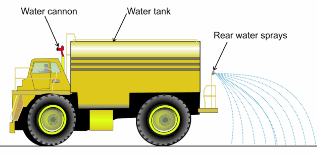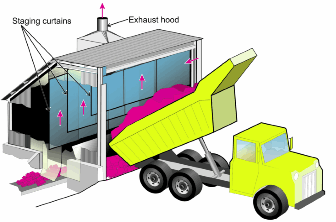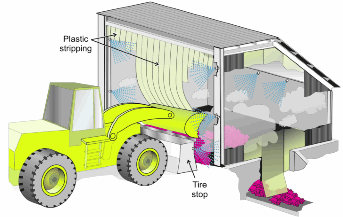The generation of excessive dust at best is a nuisance and at worst can be deadly. Working in dust causes respiratory problems. Coal dust accumulation provides the necessary link for an ignition to propagate into a full blown explosion. Fugitive emissions also send a signal that the current dust control plan is not working properly. Miners that ignore the warning are taking a gamble.
Haul trucks, which are already vision restricted, should not be navigating through dust clouds. While common sense prevails in these situations, there are also external considerations. These could be homes near the mine or communities that have to deal with coal being transported from the mine to the power plant or steel mill. Spillage and dust accumulations are a nuisance that they will not accept.
On average, U.S. power plants burn 2.5 million tons of coal per day. Some of that coal is delivered by trucks and barges, but most of that coal is shipped by rail. Unit trains pulling 100 to 150 100-ton railcars traverse the heartland and snake through the Appalachian Mountains. The dust generated by rail transportation and point loading sources is becoming a growing concern.
Citing an Australian study, U.S.-based educator and ventilation expert Jürgen Brune, a research professor at the Colorado School of Mines, noted in a 2012 white paper on the topic that 52% of total dust comes from those particulates whirled from vehicles. The second largest contributor is wind erosion at 19%.
He presented several formulas that make up the basis for a collection of effective dust control engineering solutions, but boil down to two major questions for operations: where most of the dust has developed and what processes create and generate the largest emissions, and where the greatest areas of sensitivity may exist.
Several technical measures can be taken to reduce emissions and loss, particularly coverings and the use of binding or wetting agents.
Some other alternatives include tearing or plowing of a surface to reduce wind erosion, suction systems, surface mine blasting during wet weather, and reducing fall height distances for bulk material dumping.
In a recently updated handbook for dust control in coal mining developed by the National Institute for Occupational Safety and Health (NIOSH) researchers, the experts highlighted the key factors for dust control (and overall miner health) from a key transfer location — the mine’s primary dump.

Water truck equipped with a front water cannon and rear water sprays. (Image courtesy of the National Institute for Occupational Safety and Health)
According to the handbook, dust in the mined product is released from the large volume of material being dumped in a short period of time [at this location], which quickly displaces the air in the hopper and transports the airborne dust released from dumping.
If the equipment operators dumping the mined product into the hopper have an effective enclosed cab filtration system, their exposure to this dust would be reduced. However, if other mine personnel such as crusher operators and/or maintenance workers work near this primary dump, they can be exposed to this airborne dust.
NIOSH recommends enclosing the mine’s primary hopper dump with custom-designed walls that will accommodate the vehicles in use. These walls can be stationary or removable via a flexible material; staging curtains or stilling curtains are one option that can be used in the enclosure to provide a physical barrier that keeps down the natural tendency of dust billowing.
Noting it may be a more expensive method, NIOSH researchers also examined the potential for panels of flexible plastic stripping on the dump side of the enclosure and a local exhaust ventilation system to filter dusty air from the enclosed hopper.
“This would be most appropriate when the primary dump is at a location where the dust could enter an adjoining structure or impact outside miners. Since hoppers are usually large, a significant amount of airflow would be required to create a negative pressure sufficient enough to contain the dust cloud,” they said.
The agency also recommended water spray use to suppress dust in the dump enclosure area, specifically looking at a starting point of 1% moisture by weight using prior research by Quilliam, and adjusting based on needs.
The NIOSH researchers also recommend that operations prevent dust from rolling back under the dump vehicle with a tire-stop water spray system.
In this design, a tire stop or Jersey barrier is positioned at the most forward point of dumping for the primary hopper and a water spray system can be attached to the back side of the tire stop. What results is a knocking down, or forcing, of dust that would otherwise roll under the mechanism and into the hopper.
In using this method, NIOSH stresses the use of a shield over the water spray manifold to protect it from damage from falling material.

Cross section of haul road. (Image courtesy of the National Institute for Occupational Safety and Health)
Looking specifically at haul road dust, greening — a planned placement of grass and vegetation at a site — is among Brune’s noted solutions for haul road dust, while other experts in the sector, including NIOSH’s Andy Cecala, have also indicated speed reductions at sites and greater distances between haulage vehicles to be of great advantage in the dust fight.
The importance of haul road maintenance, and increased efforts in this area, also cannot be understated. Many mines incorporate reporting systems for potential dangers into overall monitoring plans in this area.
Mines should not ignore the fact that having too much can sometimes have the opposite effect as was intended, particularly as it pertains to haul roads. Rosbury, on behalf of the U.S. Bureau of Mines, said in research that about 40% efficiency was achieved in dust binding under regular irrigation conditions; that increased to 55% when irrigation was shortened.
What can be seen over time, however, is a greater loss of road grading and condition from erosion stemming from those very same dust reduction efforts. A mixture of erosion and gravity can create a perfect storm and, ultimately, a problem for a mine.
Options for Mines and Loadouts
Research has shown that the most prolific surface dust creators are blasting, haul trucks, and loading tools, such as electric shovels, hydraulic excavators and wheel loaders. There is certainly no shortage of avenues a mine or facility can take in its efforts to keep dust at bay, much of which hinges on the type of coal being controlled, what potential issues the operation is seeking to avoid or neutralize, and environmental considerations.
In addition to the safety and environmental considerations, health of the miner is as important for the surface miner as his underground counterpart. Samples taken by federal officials from 2004-2008, the Mine Safety and Health Administration (MSHA) has said in its compiled data, reflected the presence of high silica levels — the heart of silicosis — in 11% of the group.
In fact, according to NIOSH research, mining still has some of the highest incidences of worker-related silicosis; moreover, machine operators, and specifically rock drillers, are most commonly associated with the disease and at the most severe level.
Additionally, research has uncovered that at surface mining operations, those most frequently exceeding respirable dust standards are typically mechanized equipment operators including drills along with bulldozers, scrapers, front-end loaders, haul trucks and crushers. It is from these statistics that some of the best ideas in coal dust suppression have been born.
Specially designed dust spraying equipment in the dust control sector includes Company Wrench’s Dust Destroyer, a dust suppression machine designed to take on various applications, can generate 37,500 cubic ft per minute (cfm) of fine water mist from its fan and offers water coverage of 27,000 sq ft to 196,000 sq ft, with a throw that can exceed 250 ft.
It and other models in the dust spray machine category — which also includes Dust Control Technologies’ DustBoss and its flagship unit the DB-60 with a 200-ft range that can blanket a 125,000-sq-ft area from a single location — can be operated with diesel or electric power.
Whether an operation needs to keep dust from going airborne or it wishes to keep dust particles already airborne on the ground, the application of water or chemicals, sometimes both, is often the most effective.
One other option in the suppression system and nozzle arena is Spraying Systems, whose line includes the BD WhirlJet, flat spray VeeJet, full cone FullJet, and fine spray nozzles, as well as the AutoJet system that is pre-packaged, pre-assembled, pre-tested, and can control one or many nozzles and headers.
Each has a different spray pattern for specific needs, and its AutoJet can control one or many nozzles and headers with automated chemical additive injection for consistency in use.
Agents, including polymers, are another available avenue, often with the added benefit of environmental soundness.
GE, provider of the CoalPlus technology, did laboratory testing and paired it against the experience and performance of coal mine sites where it was being applied, determining that it provided a benchmark approach that can be applied to certain type of coals worldwide.

An illustration of a staging curtain design and exhaust at a dump point. (Image courtesy of the National Institute for Occupational Safety and Health)
The research, which it said was successful in helping it find CoalPlus, was an effective inhibitor of spontaneous combustion in coal applications, found even more benefits through its work.
B3 Mining Services managing director Dr. B. Basil Beamish, whom GE teamed up with for its testing, said that the technology could be applied at various stages in the mining, handling, transport and consumption chain, as well as power plants and terminals to reduce dusting by up to 90% during loading, unloading, stack-out, and reclamation at mining utilities and coal terminals.
CoalPlus, which was initially designed for low-rank coal such as tonnage from the Powder River Basin region, also can decrease in-transit coal losses from rail cars.
GE also has the PowerTreat line of agents, including the FD foaming series, the AD antioxidant line, and its DA agglomerates for applications including plant buildings, railcars and barges.
Offering what it called a comprehensive coal dust control product line is Zinkan, which has underground environment solutions to aid in the fight against pneumoconiosis to sealing and topping and road environment products.
Zinkan’s MineReady mine dust control chemicals and mine water treatment, which the Ohio-based company defines as a particle-charged chemistry based on food-grade polymeric materials, has been designed to help operations keep coal and quartz levels within federal compliance outlines. Using water as a carrier for the product, the company said that it can reduce fugitive dust by half while using less water and has been working alongside operations as mandates of 2 mg/m3 are being cut by up to half.
Its MineReady Nofoam, Premium and AggGlu options for belt transfer points to reduce PM-10 levels in both underground and surface applications have specific rates or dosage for various scopes of need.
Additionally, the company’s DCG-350, DCG-50 and DCG-11-C are all UV-stable for sealing storage stockpiles as well as soil stabilization; the non-toxic DCG-350 has been applied as a binder to coke fines, fine coal and thermally dried coal of various rankings.
“DCG-350 has a multitude of uses and can be used on haul roads, unpaved roadways, parking lots and stockpiles,” the company said, noting that its quick drying time can allow for immediate road use after application.
“It is also stable because concentrated DCG-350 can be stored for extended periods of time,” Zinkan said.
DCG-50, which forms a film to penetrate surfaces, develops a water-resistant “crust” that can be a long-term method for storage and transit along with overall dust suppression.
DCG-110-C, used more for roadways and commercial properties, is a natural by-product tress with lignin, a polymer that binds together tree fibers and is secured during the process of paper production. The company has received dust control approvals for the product in Pennsylvania and West Virginia. It is touted as a non-chloride alternative to improve the quality of a roadway and reduce gravel loss when used as a binder.
With the transport of coal over long distances, often stockpiled at different points between mining and end use, both dust and combustion may become an issue, especially at the blending beds of power generation facilities and ports.
A method not commonly practiced in the U.S. to date in the coal sector, at least not as widely as it could be, is the use of domes and stockpile coverings. Without a mandate in place that would require the use of such products, cost is among the many reasons operations and facilities opt for other methods.
Large storage dome producer Geometrica pointed out that there are just two points needed to create a coal storage explosion: an explosive dust cloud and ignition. A cloud can be created by the simplest of events, such as machinery vibration, to wind or even an earthquake, and conveyed hot material can be enough to create an ignition, as can lightning, welding or a static spark.
While it is important to work storage piles to prevent “dead pockets,” monitor for hot spots and keep coal stocks dry no matter the location, Geometrica noted that domes can protect piles from the sponcom-fostering rain and wind that are hard to escape while also reducing air and runoff pollution.
The company designs systems with various cladding options, which can provide additional protections over conventional I-beam systems that can allow explosive coal dust to accumulate on beam ledges.
A breakaway panel on the units can allow for accidental overloading and ventilation at the base, the company added, and exhaust fans or ventilation openings keep methane and smoke build-up at bay.
Geometrica has so far built domes for every coal pile shape, from ring and conical to longitudinal and free-form, with sizes ranging from a 66-m diameter dome over a 15-m wall for the storage of 35,000 tons to a 125-m dome over an 18-m wall to contain 180,000 tons.
The Mobile Issue of Coal Dust
Much discussion on respirable coal dust for underground coal miners, and reducing that exposure, has been seen, and this year, federal officials are eyeing further changes on exposure outlines — despite the high costs associated with that. On the surface, the point of contention in many ways is coal dust’s impact on the air and water not only where it is stored, but where it is traveling to.

Illustration of a wet dust control approach with partial enclosure at a crusher dump loading operation. (Image courtesy of the National Institute for Occupational Safety and Health)
With the increased interest in export facilities in the Pacific Northwest, the topic of dust exposure and its impact on the air, water and overall environment has become hot for both coal supporters and opponents. While environmental groups are citing hazards in a fight to stop facility development — six potential ports just 18 months ago are now just three — the coal community has been making strides in finding new ways to allow coal transport across the states and to the waterways while being a good neighbor.
For one large national railroader, that progress is evident. In December, the U.S. Surface Transportation Board (STB) decided that Burlington Northern Santa Fe can require its shippers to use coal dust suppression. The decision came six months after port opponents and environmentalists sued the company for related federal Clean Water Act violations.
Just before Christmas, the STB said that those shippers that had opposed BNSF’s outlines did not prove that they were unreasonable.
In a lawsuit filed last June by the Sierra Club, Puget Soundkeeper, Columbia Riverkeeper and environmentalists in Washington state, the groups made claims that the line’s trains discharged coal, coal dust and chunks, and other pollutants into water bodies, leaving harmful mercury, arsenic and uranium concentrations.
BNSF spokeswoman Courtney Wallace said when the judgment was made that the STB’s judgment would ensure that coal dust remains where it belongs: in its railcars, just as they were loaded.
“We established our coal loading rule after extensive field testing, and when properly followed, our rule effectively addresses issues with coal dust,” Wallace said.
At the same time, she called the Sierra Club’s suit a publicity stunt aimed at its more major mission to stop coal exports in the region.
The railroader, which operates largely in the western U.S. states and considers coal one of its largest carried commodities, has been working to reduce coal dust on its lines for track stability and overall line operation.
Some of that stemmed from a previous STB decision in March 2011 stating that dust emissions from open-top railcars were creating issues with track beds; in new rules issued in July 2011, the railroader said it would require coal loadings to have a bread loaf shape and be sprayed with a topper agent for dust suppression.




